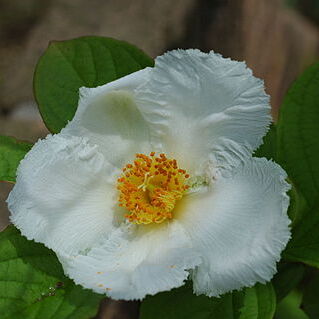Shrubs or trees, 3-6[-20] m. Stems usually 1; bark thin, closely fissured or exfoliating. Leaves deciduous [persistent]; petiole distinct from blade, winged; blade ovate to elliptic, chartaceous [coriaceous], base cuneate to attenuate or rounded, margins erose or serrulate, apex acute to acuminate, veins conspicuous, 5-8[-12] pairs, midrib elevated abaxially. Inflorescence bracts usually persistent, 1-2, immediately proximal to calyx. Pedicels terete, 0.2-0.7[-4] cm. Flowers [2-](5-)6-10(-12) cm diam.; sepals persistent, 5, connate proximally, concave, leaflike, thick and becoming lignified proximally, margins ciliate, apex acute, sericeous; petals 5(-8), connate proximally, white or creamy white, unequal, base pubescent and constricted, margins crenulate to erose, outermost petal slightly curved, abaxial surface silky or pubescent; stamens (50-)75-125(-150), connate basally; pistil (4-)5(-6)-carpellate; ovules 2-4 per locule; styles 1 or 5; stigmas [4-]5[-6]-lobed or unlobed. Capsules brown, conic, base rounded, apex acute, dehiscence loculicidal; columella absent. Seeds 2(-4), brown or reddish brown, angular, lenticular, or planoconvex, asymmetric, smooth, marginal wing present or absent. x = 15 (18).
Pet 5(6), white, barely connate at base, pubescent beneath; stamens numerous, the filaments united at base into a narrow ring adnate to the base of the corolla; ovary 5-locular; capsule woody, with 1–4 seeds per locule, splitting from the top down; sep persistent into fr; shrubs or trees with deciduous lvs and large white fls short-pediceled or subsessile in the axils. 6, the other 4 in e. Asia.

